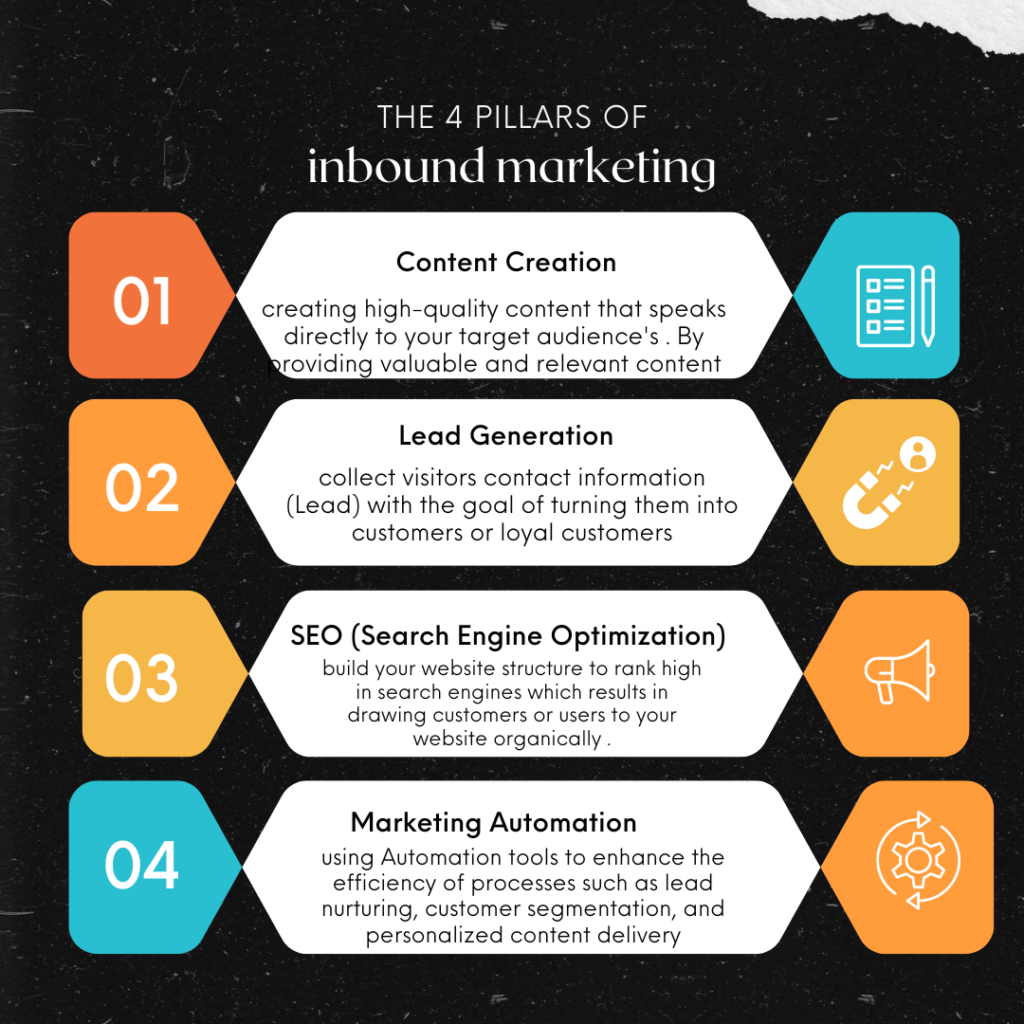Inbound Vs Outbound Marketing : Which Strategy to Use in 2024?
Welcome Webmaster’s And Digital marketers. Today, we will discuss a common question that arises when people begin learning about digital marketing or when business owners aim to boost their revenue: choosing between inbound and outbound marketing strategies.
Table of Contents
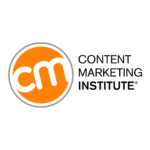
Content Marketing Institute
What is Inbound Marketing ?
some people refer to inbound marketing as "modern" because the term "inbound" didn't emerge until 2005 .
Inbound marketing is a digital marketing strategy to attract potential customers to your business or brand website by creating useful content that resonates with your target audience using social media networks, SEO , SEM And content marketing .
pillars of inbound marketing
There are 5 important pillars of inbound marketing :-
- Content Creation: : One of the key pillars of inbound marketing is creating high-quality content that speaks directly to your target audience's . By providing valuable and relevant content, you can attract potential customers organically .
- Lead Generation : collect visitors contact information (Lead) for those who are interested in a specific product or service with the goal of turning them into customers or loyal customers
- Social Media Marketing (SMM) :
- Social media platforms such as LinkedIn, Facebook, Instagram, Twitter, and even Pinterest helped in leveraging inbound marketing strategies by engaging directly with the audience, which helped turning viewers into customers and helps in building brand awareness.
- SEO (Search Engine Optimization) When building a website, the first step before doing anything is to build your website structure to rank high in search engines which results in drawing customers or users to your website organically .
- Lead nurturing : is the process of building relationships with your prospects and staying with them at every stage of the sales funnel until they are ready to make a purchase.
- Email Marketing: sending tailored, valuable emails to leads and customers to educate, nurture, and convert them over time to buyers or loyal customers
- Marketing Automation : using Automation tools to enhance the efficiency of processes such as lead nurturing, customer segmentation, and personalized content delivery By automating repetitive tasks, businesses can ensure that their marketing efforts are more consistent and personalized, leading to stronger relationships with prospects and customers. which ultimately drives more conversions.
Benefits of inbound marketing
In 2024, digital marketers and business owners must get rid of outdated marketing tactics and try refreshing alternatives to traditional advertising, such as inbound marketing. So what makes it stand out?
- Customer Magnet: Inbound marketing attracts potential customers who are already interested in what you offer. by creating valuable content that resonates with the audience and draws them organically, which builds trust and brand loyalty.
- Cost-Effective: One of the biggest advantages of inbound marketing is that it is cost effective, which requires only investing in SEO and content creation . and it offers a better return on investment (ROI) compared to traditional advertising methods.
- Measurable Results : Inbound marketing enables you to measure and assess the results of your efforts more closely, providing insight into which content resonates with your audience, lead generation efforts, and conversion rates; all of which provide data to enhance strategy with maximum impact.
Building Trust and Credibility : Inbound marketing increases the trust of visitors to your site because they've done it without having to present advertising material at the first place .
Increase Brand Awareness : Brand recognition is another benefit of inbound marketing . By creating high-quality content that resonates with the audience, you can improve brand visibility, increase the exposure of your brand, entice more customers, and establish trust with prospective customers.
There is an insightful article that talks about the benefits of inbound marketing here for more information .
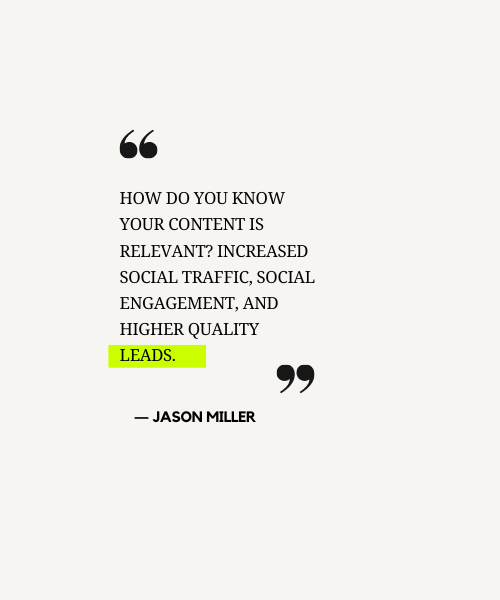
Strategies for successful inbound marketing
Businesses today must find innovative strategies to capture the attention of their target audience and stay competitive in today's fast-moving digital landscape. Inbound marketing has quickly emerged as a potency strategy that seeks to draw customers through valuable content and experiences rather than intrusive advertising. By understanding consumer behaviors and preferences, businesses can tailor their marketing initiatives to seamlessly fit into the buyer journey. Successful inbound marketing relies on employing effective strategies that not only drive traffic but also convert leads into loyal customers.
- Content marketing : is a strategic way to create and share helpful content to attract a specific audience and get them to take action. It's different from regular marketing, which interrupts with ads. Instead, content marketing gives useful information to solve problems and build loyalty and engagement.
- Create buyer persona : A buyer persona is a virtual representation of the ideal customer that you want to advertise your products to .
- Partnering with influencers : can boost your brand's visibility and credibility. These online personalities have loyal followers who trust them because of their authentic content. By teaming up with influencers, you can reach their audience and promote your product to a receptive group that values their opinions.
- Use Landing Pages: Create specific landing pages for different campaigns. These pages should include compelling calls-to-action (CTA) and lead magnets such as free trials or webinars to convert visitors into leads.
- Email Marketing: Develop personalized email campaigns to nurture leads. Share valuable content, company updates, and exclusive offers to keep your audience engaged.
- Analyze and adapt: Utilize analytics tools to track the performance of your strategies. Analyze the data to understand what's working and adapt your approach to improve your results continuously.
Measuring inbound marketing Success
Measuring success in inbound marketing is essential for understanding the effectiveness of your strategies and making informed decisions for future campaigns.
So what metrics should you keep an eye on?
- Website Traffic : which measures the volume of visitors to your site.
- Lead Generation Rates : which highlight the conversion of visitors into leads
- Bounce Rate : This indicates the percentage of visitors who leave your site after viewing only one page
- SEO Performance : which evaluates organic search ranking and visibility
Our Team wrote article about content marketing analytics which can help you measuring KPIs and other useful insights .
what is Outbound Marketing ?
Outbound marketing, often referred to as "traditional marketing," involves reaching out to potential customers regardless of whether they have shown interest in the product or service . This approach includes strategies such as
- traditional advertising on television
- radio
- print as well as direct methods like cold calling and email blasting
characteristics of outbound marketing
- Broad Audience Reach: Outbound marketing shines in its ability to cast a wide net, aiming to get your message in front of as many eyes or ears as possible. Whether it’s a billboard that thousands pass by every day or a TV commercial seen by millions, the goal is mass visibility.
- Proactive Engagement: Rather than waiting for customers to find you, outbound marketing takes the initiative. By actively reaching out through methods like cold calls and direct mail, businesses chase potential leads instead of attracting them passively.
- Highly Targeted (When Done Right): With advanced demographic and psychographic targeting techniques, modern outbound marketing can still be highly precise, ensuring that your message reaches the most relevant audience segments.
- Immediate Results: For companies looking for a quick boost in visibility or sales, outbound marketing can deliver fast results. Campaigns can be launched swiftly, making it a go-to strategy for businesses needing to meet short-term goals.
- Easily Measurable: Outbound efforts can be directly measured, especially in terms of campaign reach and initial response rates. This allows for quick adjustments and optimization to improve effectiveness.
- Higher Cost Investment: The broad reach and proactive nature of outbound marketing typically comes with a higher price tag. Investments in media buying, production, and distribution can add up quickly.
- Potential for Lower Engagement Rates: Due to its broad approach, outbound marketing may lead to lower engagement compared to inbound strategies. The challenge lies in breaking through the noise and capturing the attention of those who are genuinely interested.
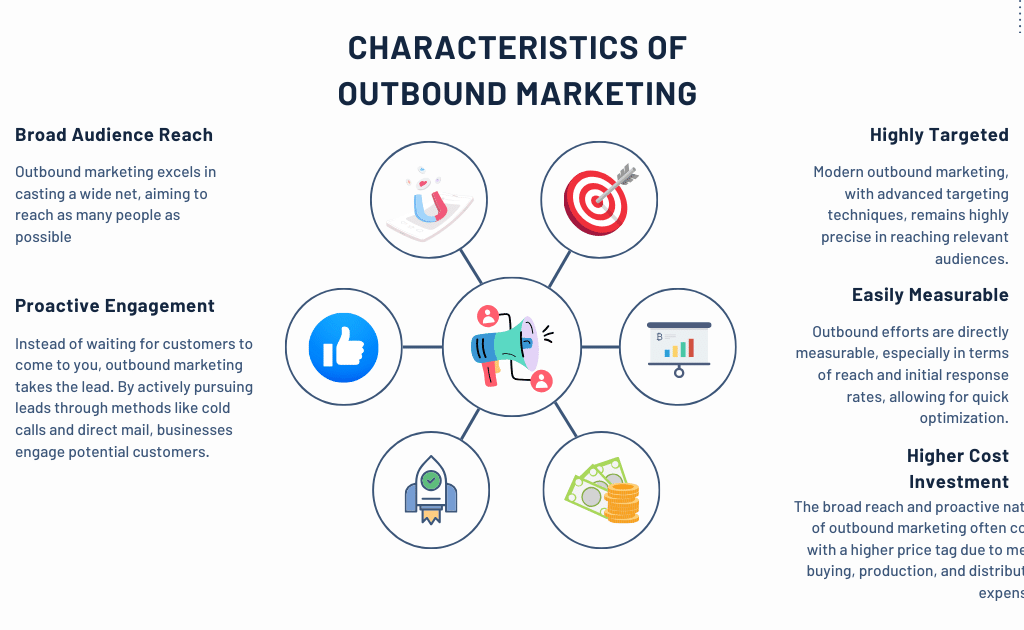
Strategies of Outbound Marketing
Outbound marketing includes a variety of strategies that aim to directly communicate a company's message to a broad audience. These strategies consist of:
Traditional advertising: using platforms such as TV, radio, and print advertisements to reach a broad audience. While digital platforms are more popular these days, traditional ads still prove successful for targeting specific demographics and industries.
Cold Calling: Making phone calls to potential customers. this method has the power to generate immediate responses and lead to direct sales if executed successfully.
Email blasting: sending promotional emails in bulk via an email list. This strategy seeks to reach many people simultaneously but requires careful segmentation and personalization in order to reduce spam rates.
Direct Mail: Sending physical promotional materials such as brochures or catalogues directly to customers' homes and businesses stands out in today's digital-dominated world, and can draw them in through tangible engagement.
Paid Online Advertising: Although technically not traditional outbound marketing methods, pay-per-click ads that reach specific demographics or interests through platforms like Google, Facebook, and LinkedIn can still count as outbound marketing due to their proactive nature and proactive reach-outs.
Traditional advertising (TV, radio, and print ads) in outbound marketing
Outbound marketing relies heavily on communication channels like radio and television ads for maximum reach, as these allow businesses to spread their message widely and create brand recognition among potential customers.
radio ads reach audiences during daily commutes .
print ads, such as newspapers and magazines, reach readers with specific interests or demographics
although these traditional methods often come at high costs and prove difficult in measuring direct impact on sales.
Cold calling and email blasting in outbound marketing
Cold calling and email blasting take an aggressive approach to outbound marketing, seeking to initiate contact with potential customers directly.
Cold calling involves calling individuals or businesses without prior contact in an attempt to engage their interest or sell a product or service.
email blasting involves sending bulk emails directly into an audience's inboxes which risk being seen as spam
Both efforts work best when targeting a carefully researched target market that you know will respond with personalized communications that build rapport and creates customer relationships through personalized conversations that bring relevance.
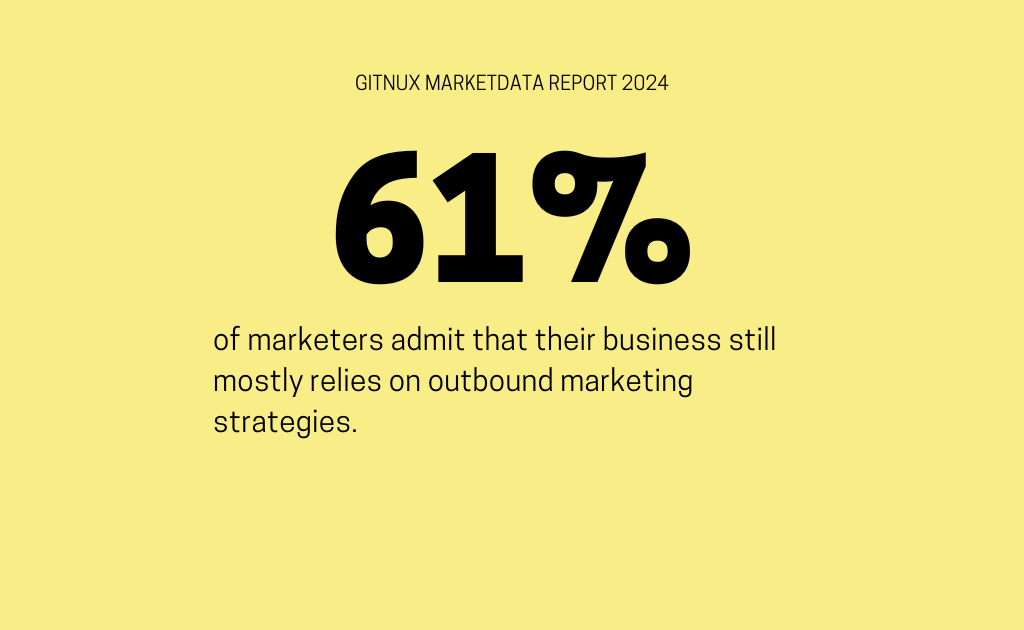
Pros of outbound marketing
Now you are going to talk about the pros and cons associated with outbound marketing strategies.
Wide Reach : Outbound marketing can reach a wide audience quickly, making it ideal for building brand recognition.
Beneficial for Certain Demographics : Outbound marketing may prove especially successful at reaching older demographics who might otherwise respond more readily to traditional forms of advertising such as TV and print media.
Immediate Results : Telemarketing can produce immediate sales results or immediate responses, while targeted messaging increases chances of reaching prospective customers and ultimately closing deals.
Brand Reputation : Outbound marketing efforts that remain consistent over time can help build and reinforce brand recognition in the marketplace.
Increased customer retention: By maintaining a direct and continuous line of communication with customers through outbound marketing efforts, businesses can foster stronger relationships, increase loyalty, and ultimately, retain more customers over time.
Disadvantages Of Outbound Marketing
Outbound marketing techniques that involve reaching out to potential customers through traditional means such as TV advertisements, telemarketing, and direct mail are increasingly becoming outdated in today's fast-evolving marketing environment.
While these traditional tactics may achieve broad reach and visibility for marketers in traditional settings, such as television commercials or telemarketing tele sales and direct mail, their effectiveness in the digital age may be less clear cut. Below are some key drawbacks of outbound marketing:
- High Cost and Lower ROI: Outbound marketing tactics are often expensive to execute and may yield a lower return on investment compared to inbound marketing strategies.
- Difficulty in Tracking Performance: Measuring the effectiveness of outbound marketing campaigns can be challenging, making it hard to optimize strategies and allocate budgets efficiently.
- Intrusiveness and Negative Perception: Many consumers find outbound marketing techniques intrusive, leading to negative perceptions of brands that rely heavily on these tactics.
- Decreasing Effectiveness: With the rise of ad blockers and declining attention spans, traditional outbound marketing methods are becoming less effective in capturing consumer attention.
- Lack of Personalization: Outbound marketing often lacks the personalized touch that today's consumers expect, making it difficult to build meaningful customer relationships.
Comparing Inbound and Outbound Marketing
Differences in Approach and Methodology
- Inbound Marketing: Focuses on creating valuable content and experiences tailored to specific audience needs, drawing customers to your products or services.
- using : Content creation, SEO, social media marketing.
- Outbound Marketing: Involves reaching out to potential customers through traditional methods or digital channels, regardless of their interest level.
- using : Cold calling, direct mail, traditional advertising.
Cost-Effectiveness
| Inbound Marketing | Outbound Marketing |
|---|---|
| Generally more cost-effective over time. It relies on creating content that continues to attract and engage users without ongoing costs. | Often higher initial costs due to the expense of traditional ad spaces and campaigns that might not have a long-lasting impact. |
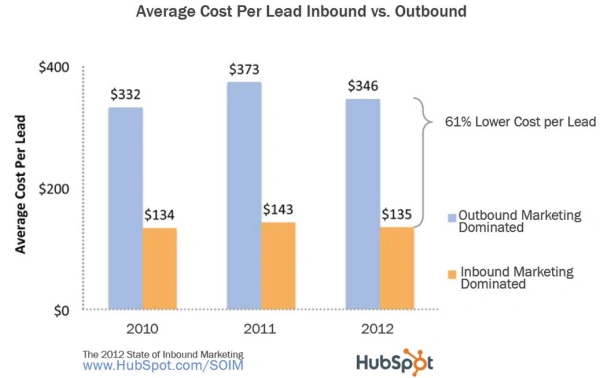
Audience Targeting
| Inbound Marketing | Outbound Marketing |
|---|---|
| Utilizes detailed buyer personas to create content that attracts a specific audience, encouraging organic engagement through quality content. | Targets a broader audience, often using a "one-size-fits-all" message, which might lead to lower engagement rates. |
Metrics for Success in Both Approaches
Measuring success and using KPI(s) is very important when using strategy wither for inbound or outbound marketing . you can learn more about it here .
| Inbound Marketing | Outbound Marketing |
|---|---|
| Inbound Metrics: Website traffic, lead generation rates, social media engagement, SEO rankings. | Outbound Metrics: Response rates, reach and impressions, direct sales numbers, campaign ROI. |
Combine Inbound and Outbound to Maximize Results
Potential Benefits
- Enhanced reach through combined efforts of targeted and broad strategies.
- Improved engagement by using outbound methods to promote valuable inbound content.
- Increased flexibility in adjusting strategies based on real-time feedback and results.
Examples of Successful Blended Marketing Strategies
- Social Media Ads promoting free, valuable content resources like eBooks or webinars.
- Email Campaigns that deliver personalized content to segmented lists, based on user behavior and preferences.
conclusion
inbound and outbound marketing both play crucial roles in a company’s overall marketing strategy. While outbound tactics like advertising and cold calling can generate immediate leads, inbound strategies such as content marketing and SEO have the potential for long-term success and brand loyalty. The key is to find a balance between the two approaches to maximize results. By understanding the strengths and weaknesses of each, businesses can create a comprehensive marketing plan that effectively reaches their target audience. Embracing a holistic approach that combines inbound and outbound strategies will lead to sustained growth and success in today's competitive market. Make sure to evaluate your current marketing efforts and consider incorporating elements of both inbound and outbound strategies for optimal results.
